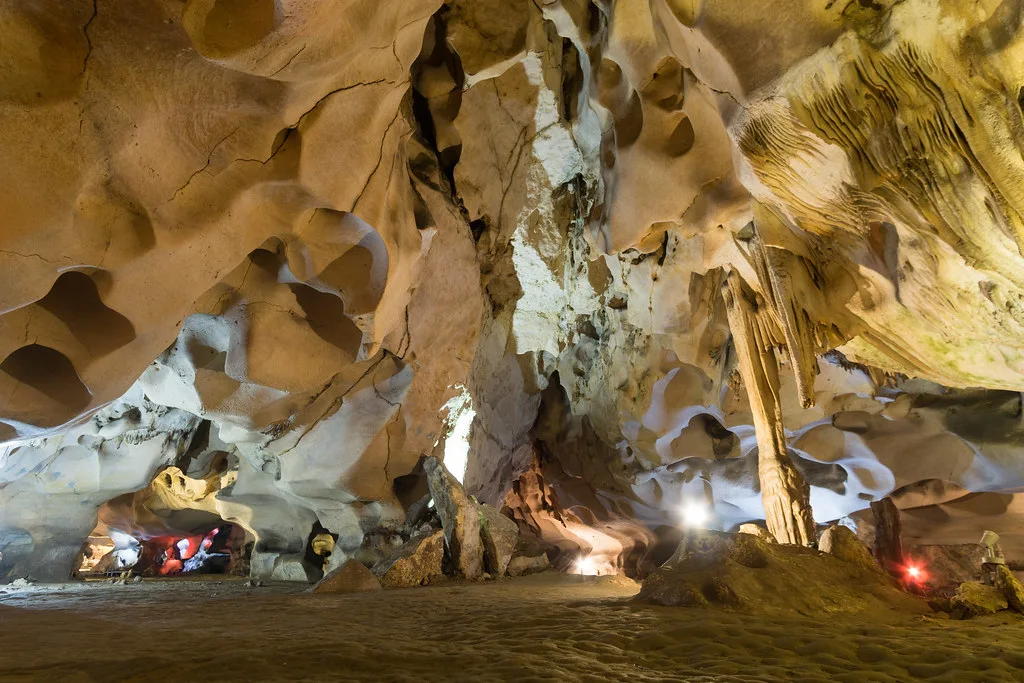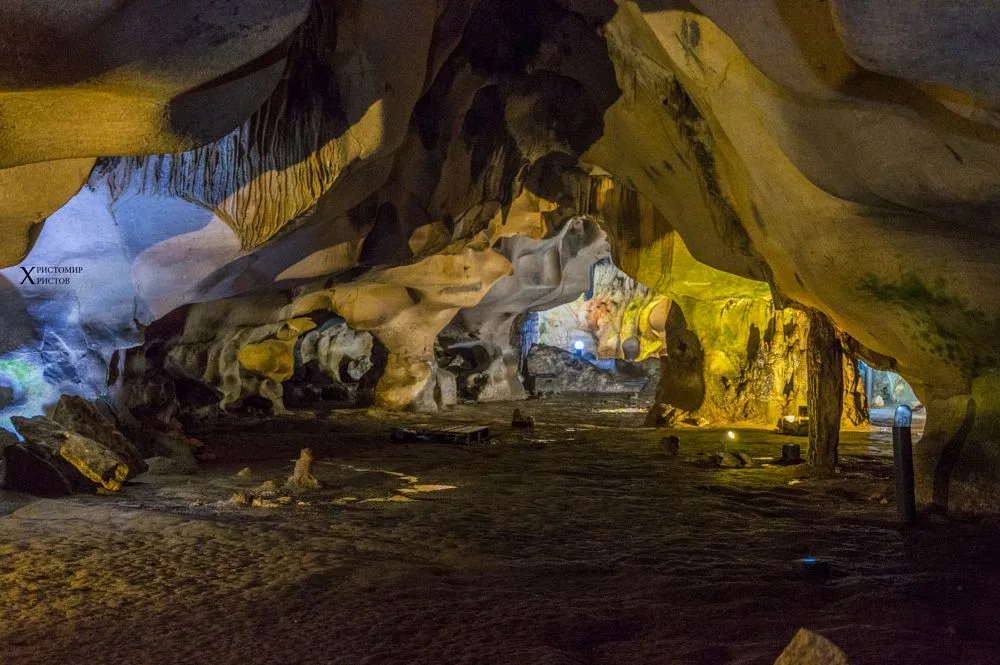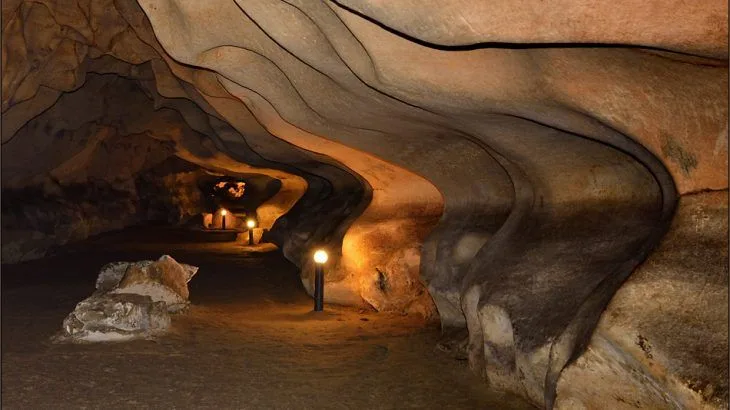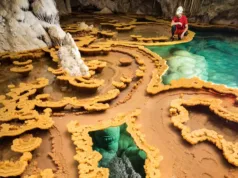Orlova Chuka Cave is a notable cave located in Bulgaria, known for its unique geological formations and historical significance. Orlova Chuka Cave is situated in the northeastern part of Bulgaria, near the town of Russe. It is part of the limestone plateau of the Rusenski Lom Nature Park, which encompasses a diverse range of natural and cultural attractions.

Geography: The cave’s entrance is situated on the northern slopes of the Rusenski Lom Nature Park, overlooking the picturesque valley of the Rusenski Lom River. The cave itself is formed within limestone rock, and it boasts a fascinating network of chambers, passages, and impressive stalactite and stalagmite formations.
Significance:
- Geological Wonder: Orlova Chuka Cave is renowned for its stunning geological features. It houses some of the most remarkable speleothems in Bulgaria, including vast chambers adorned with intricate stalactites and stalagmites. Visitors can explore the cave’s labyrinthine formations and witness the unique interplay of light and shadow within its depths.
- Cultural and Historical Relevance: The cave has a rich history, with evidence of human habitation dating back thousands of years. Archaeological excavations in and around the cave have unearthed tools, pottery, and artifacts from different historical periods, shedding light on the region’s past.
- Biodiversity: Beyond its geological and historical significance, Orlova Chuka Cave also supports a diverse ecosystem. The cave’s microclimate provides a home for various species of bats and other cave-dwelling creatures.
- Tourism and Education: The cave is a popular tourist attraction and offers guided tours for visitors interested in exploring its wonders. It serves as an educational site where people can learn about the unique geology, history, and biodiversity of the region.
In summary, Orlova Chuka Cave is a fascinating natural wonder with a rich history and cultural significance. Its unique geological formations and historical artifacts make it a valuable site for both tourists and researchers interested in Bulgaria’s natural and cultural heritage.
Geological Formation of Orlova Chuka Cave

Geological Formation: Orlova Chuka Cave, like many other caves, owes its existence to the processes of karstification. Karstification is the dissolution of soluble rocks, typically limestone, by acidic water. Over thousands of years, the following processes contributed to the formation of the cave:
- Limestone Bedrock: The cave is primarily formed in limestone rock, which is highly susceptible to dissolution by water. Limestone is composed of calcium carbonate, and when rainwater mixes with carbon dioxide from the atmosphere, it becomes slightly acidic, enabling it to erode the limestone over time.
- Chemical Erosion: As rainwater percolates through the limestone, it gradually dissolves the rock, creating cracks and cavities within it. This process is known as chemical erosion.
- Mechanical Erosion: Flowing water carries away the eroded particles, widening existing cracks, and creating underground channels and chambers. Mechanical erosion is particularly significant in the formation of cave passages.
Notable Geological Features: Orlova Chuka Cave is celebrated for its extraordinary geological features, including:
- Stalactites and Stalagmites: The cave is adorned with impressive stalactites (hanging formations) and stalagmites (rising formations) created by the deposition of dissolved limestone minerals. These formations can take thousands of years to develop and are among the most captivating features of the cave.
- Curtains and Flowstones: Flowstones are formed by calcium carbonate-rich water flowing down the cave walls and creating smooth, undulating sheets of mineral deposits. These flowstones can resemble curtains or frozen waterfalls, adding to the cave’s aesthetic appeal.
- Columns and Pillars: In some parts of the cave, where stalactites and stalagmites have grown together, they form columns and pillars, giving the cave an otherworldly appearance.
Ongoing Evolution: Orlova Chuka Cave is a dynamic geological environment, and it continues to evolve, though at a very slow pace. The cave’s evolution is primarily driven by ongoing chemical and mechanical processes. Factors that contribute to the cave’s ongoing evolution include:
- Water Seepage: Water continues to percolate through the limestone, dissolving it and forming new passages or enlarging existing ones.
- Stalactite and Stalagmite Growth: The stalactites and stalagmites within the cave continue to grow as mineral-rich water drips and evaporates, adding layers of mineral deposits. This process is incredibly slow, with stalactites growing only a few millimeters per year.
- Cave Collapse and Reformation: Over long periods, cave collapses can occur, leading to the formation of new chambers and passages. These collapses are often triggered by the weakening of the cave’s structure due to erosion and the shifting of underground watercourses.
While the geological changes within the cave are imperceptible on a human timescale, they are an integral part of the cave’s ongoing evolution, shaping its unique features and character over geological time.
Tourism and Visitor Information

Tourism at Orlova Chuka Cave is an important aspect of its significance, as it allows visitors to explore its geological wonders and learn about its history and cultural importance. Here’s some visitor information for those interested in experiencing the cave:
1. Opening Hours:
- The cave typically has set opening hours, which can vary depending on the season. It’s advisable to check the current opening hours in advance to plan your visit accordingly.
2. Guided Tours:
- Orlova Chuka Cave offers guided tours to visitors. It’s highly recommended to take a guided tour, as the knowledgeable guides can provide valuable insights into the cave’s geology, history, and the significance of its formations.
3. Ticket Prices:
- There is usually an entrance fee to visit the cave, and the cost may vary for adults, children, and students. It’s a good idea to check the current ticket prices before your visit.
4. Accessibility:
- It’s important to consider the cave’s accessibility. While the entrance and initial sections of the cave are often easily accessible, some parts of the cave may require climbing and may not be suitable for those with mobility issues.
5. Dress Code:
- Visitors should wear appropriate clothing and footwear for cave exploration. Comfortable walking shoes with good traction are recommended, and it’s a good idea to bring a light jacket as cave temperatures can be cooler than the outside.
6. Photography:
- Some caves restrict or charge for photography. Check the cave’s policy on photography before your visit, as it may impact whether you can take photos during the tour.
7. Safety Precautions:
- Follow the safety guidelines provided by the cave authorities and your guide. This may include not touching the formations, staying on designated paths, and respecting the cave’s rules.
8. Educational Experience:
- Orlova Chuka Cave is not only a tourist attraction but also an educational site. Take the opportunity to learn about the geological processes that formed the cave and the history of human activity in and around it.
9. Visitor Center:
- Many caves have visitor centers where you can find additional information, maps, and exhibits related to the cave’s geology and history.
10. Nearby Attractions:
- When planning your visit, consider exploring other attractions in the surrounding area, such as Russe, the Rusenski Lom Nature Park, and any other historical or natural sites of interest.
Remember that visiting a cave is a unique experience, and it’s important to be respectful of the fragile and irreplaceable natural formations within. Following the rules and guidelines set by the cave authorities will help preserve these wonders for future generations.
Cultural and Historical Significance of Orlova Chuka Cave

Orlova Chuka Cave holds cultural and historical significance due to the evidence of human habitation and activities in and around the cave dating back thousands of years. Here are some key aspects of its cultural and historical importance:
- Archaeological Discoveries: Archaeological excavations in the vicinity of Orlova Chuka Cave have revealed a treasure trove of artifacts from various historical periods. These include tools, pottery, and other items that provide valuable insights into the lives of the people who lived in the region in ancient times. The artifacts have been linked to various historical periods, including the Neolithic, Bronze Age, and Iron Age.
- Early Human Settlement: Some of the artifacts discovered in the cave’s vicinity suggest that the cave may have been used as a shelter or dwelling place by early humans. The presence of such artifacts indicates that the cave played a role in the region’s early settlement and served as a refuge for its inhabitants.
- Cultural and Historical Context: The cave’s archaeological findings contribute to a better understanding of the cultural and historical context of the region. They shed light on the ways of life, technology, and societal organization of the people who lived in the area during different periods of history.
- Historical Preservation: The preservation of these archaeological artifacts and the ongoing study of the cave’s history are of great cultural importance. They help to connect modern Bulgarians and visitors to the rich history and heritage of the region.
- Educational Value: Orlova Chuka Cave, with its historical significance, serves as an educational site where visitors can learn about the past of the area, the evolution of human societies, and the ways in which ancient civilizations interacted with their natural environment.
- Tourism and Cultural Awareness: The accessibility of the cave and the guided tours provided to visitors offer an opportunity to raise awareness of the historical and cultural significance of the site. This fosters a greater appreciation for the region’s heritage and history.
In summary, Orlova Chuka Cave’s cultural and historical importance lies in the evidence of human presence and activities within and around the cave dating back thousands of years. The archaeological discoveries contribute to our understanding of the region’s past and the ways in which early human societies interacted with their environment. This cultural and historical significance is not only important for research but also for the cultural identity of the region and its potential for educational and tourist purposes.




































